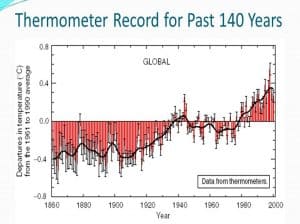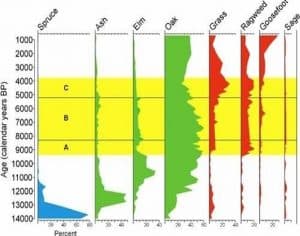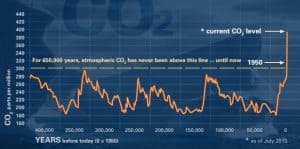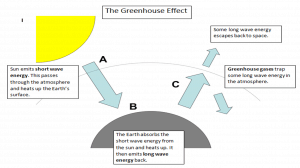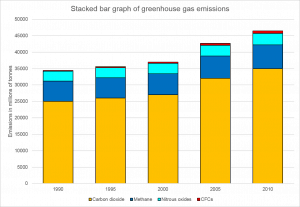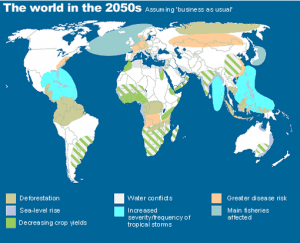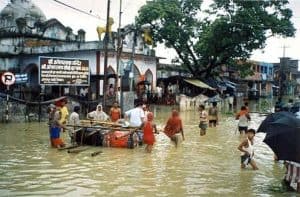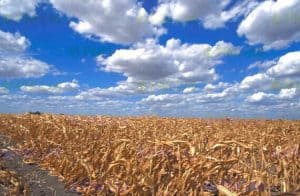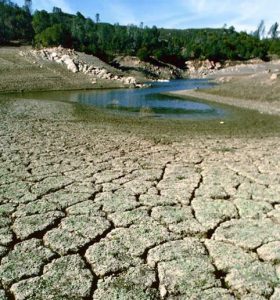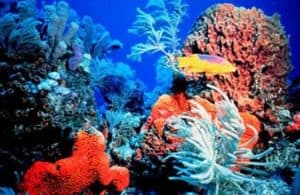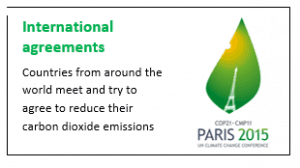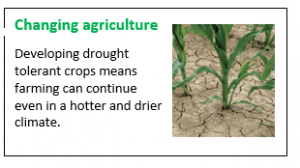Since the last ice age the world has experienced several warm periods  and several colder periods. Today the world is at least 5 degrees C warmer than at the end of the last ice age 10 000 years ago.
and several colder periods. Today the world is at least 5 degrees C warmer than at the end of the last ice age 10 000 years ago.
Evidence for climate change over the Quaternary Period
The Quaternary Period is the most recent period of geological time – the last 2.5 million years.
We have records of temperatures going back to the 19th century. The graph below shows that the world seems to be getting warmer.
Evidence for climate change comes from pollen analysis of sediments from lakes and swamps. These build up over time trapping the pollen from plants. The graph below shows that spruce pollen disappeared from this area 11 000 years ago and was replaced by different species. This also suggests that climate is getting warmer.
Evidence for changing temperatures comes from the gases trapped in bubbles in ice. The bubble captures the concentration of carbon dioxide in the atmosphere when it was formed. The graph below shows that carbon dioxide has risen and fallen several times, possibly altering our climate.
Finally oxygen isotope analysis from ocean sediments shows the world has undergone many fluctations in climate over the Quaternary Period.
Causes of climate change
Natural causes of climate change are:
- Orbit geometery – sometimes the Earth’s orbit is circular and sometimes it’s more elliptical. As the distance between the Sun and Earth change so does our temperature.
- Axis tilt – the Earth’s axis tilt changes and wobbles pointing the planet towards or away from the Sun, affecting out temperature.
- Volcanic eruptions – the eruption emits sulphur dioxide and ash into the atmosphere, blocking out the Sun and making our world colder.
- Solar ouput – sometimes the Sun emits more or less radiation, which will alter our climate.
Human causes of climate change are:
- Burning fossil fuels – when fossil fuels are burnt, carbon dioxide is emitted and this contributes to climate change.
- Deforestation – removing trees leads to increased levels of carbon dioxide in the atmosphere and a warmer planet.
- Agriculture – more cattle kept for meat means more methane emissions and this is another greenhouse gas.
The main greenhouse gases are: carbon dioxide, methane, CFCs and nitrous oxides.
- Carbon dioxide is the most important contributor to global warming. It comes from burning fossil fuels and deforestation.
- Methane comes from agriculture, such as keeping more cattle and from rice paddy fields.
- CFCs are refridgerants from fridgesand freezers.
- Nitrous oxides are from agriculture and industry.
As man produces more greenhouse gases, their concentration in the atmosphere increases. As a result more long wave energy is absorbed by these gases in the atmosphere. Therefore the world’s temperature rises. This is known as global warming.
The effects of climate change
Effects on people
Rising temperatures may lead to more evaporation and more rainfall. Flooding may occur more frequently in countries such as Bangladesh, with greater loss of life and damage.
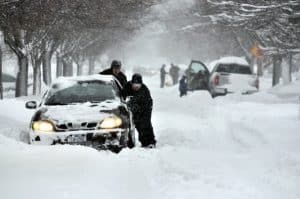 More warm, moist air meeting cold air from the poles may lead to more snow storms and blizzards in the USA and Canada.
More warm, moist air meeting cold air from the poles may lead to more snow storms and blizzards in the USA and Canada.
A warmer climate may produce less rain and this may lead to crop failures and famines in Eastern Africa.
 More famines may cause more migration as people move away from areas that are now too dry to grow food.
More famines may cause more migration as people move away from areas that are now too dry to grow food.
Effects of the environment
As glaciers and ice caps melt, sea levels will rise. This may flood low lying land around the coast, such as many parts of the UK.
Changing wind patterns and ocean currents may result in less rainfall and droughts across Eastern Africa.
Warmer ocean temperatures may kill coral. Bleached coral turns white. This will have a knock on effect on marine ecosystems along the Great Barrier Reef in Australia
Polar regions are predicted to warm the most. A loss of habitat will affect many polar species such as polar bears in Greenland.
Managing climate change
Mitigation = When we try to stop or limit climate change by reducing emissions of greenhouse gases.
Adaption = When we change how we live do to deal with the effects of a changing climate.
Mitigation
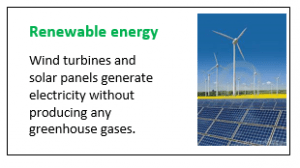 Advantages
Advantages
Reduces carbon dioxide emissions
No longer reliant on fossil fuel imports
Disadvantages
Expensive compared to fossil fuels
No sun or wind means no power
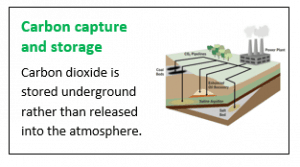 Advantages
Advantages
Stores CO2 under-ground – not in the atmosphere.
Little change needed from current activity
Disadvantages
Very expensive
The stored CO2 may leak out eventually
Does not tackle the cause of climate change
 Advantages
Advantages
Improves habitats for wildlife
Natural solution to climate change
Disadvantages
Takes up land needed for crops
Less food despite growing population
Land owners want payment
Advantages
If all countries agree – then CO2 emissions will decline
Disadvantages
Countries disagree over who should cut back their CO2 emissions the most
Adaption
Advantages
More food for a growing population
Crops may need less irrigation and pesticides too
Disadvantages
New crops too expensive for poor famers in LICs
May need genetic modification
 Advantages
Advantages
Less water wasted
Water available despite growing population and less rainfall
Disadvantages
New technology expensive to install in all homes
 Advantages
Advantages
Protects land from rising sea levels.
Cheaper than letting more floods happen
Disadvantages
Expensive to build and repair
Does not tackle the cause of climate change
